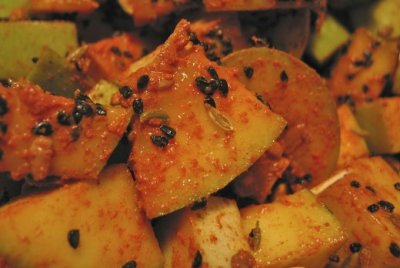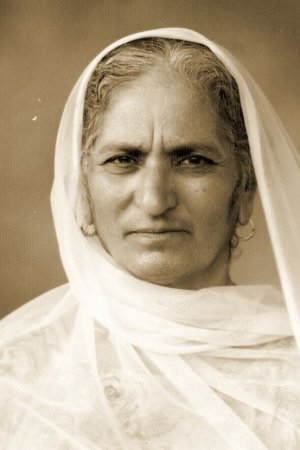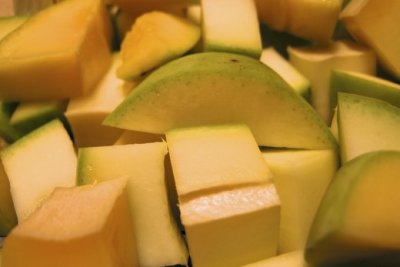Editor's Note: Sarah is a Pakistan born American who loves food,spices, nutrition and has a PhD on integrative medicine studying the affect of Ayurveda, Chinese and Allopathic medicine on Diabetes Type II. This intrepid foodie went transcontinental in trying to trace and recreate that exact mango pickle recipe her grandmother made. Sarah recalls this sojourn from her memory buds. She says,’the act of reinventing her recipe is a refuge, ritual, thread and silsila (chain) back to her with a hint, dash and a pinch of improvisation thrown in over time. Truly, a united subcontinent of the mango!
Though I don't remember my Nano, my mother's mother, when I re-create her mango pickle dish, I taste her memory. Apparently my Nano pampered me during my first two years of life. Rumor has it that my family hoped that I, the third child, would be the first son. When I fell ill after birth, Nano frantically prayed for my recovery and regretted that she had ever thought I should be a boy. She passed away a few years after my parents, two sisters and I planted ourselves in New England.
Inside our colonial brick house in central Connecticut, food dominated each day. Sitting in his living room chair, smoking his Marlboro Lights cigarette and dressed in hip '70s plaid, bell-bottomed trousers of the time, my father would ask, "Sweetheart, how can you dislike a food if you have never tasted it?" Eagerly, I would exclaim, "Did you know that some of my classmates hate peas, spinach and broccoli?"
Obviously, many of my peers had never savored my mother's muttar pilau(peas and rice) with each rice grain perfectly separated, ghee-glistening elegantly amid five spices and the Jolly Green Giant's now unfrozen peas. Nor had they relished her saag gosht (spinach and lamb) with lamb seared in her owngaram masala (a spice mixture) and onions, a dash of dried fenugreek leaves, spinach, a bit of broccoli and plenty of sour cream. I did not realize at the time that these spices were "other" and "exotic." Didn't all families relish in such tasty fare?
A kid in the spice cabinet
But my favorite foods, the things that I was reprimanded to eat only in small quantities, the things that suffused my mouth with myriad flavors and even more possibilities, were the achārs, pickles and chutneys. I craved these dishes that were sweet, spicy, oily, pungent, salty, sour, and just bursting with flavor. My favorites were Pachranga's sweet and spicy eggplant pickle, hot lime pickle, spicy mango pickle, garlic pickle, hot and spicy green chili pickle. I also loved my father'stamarind chutneys with fresh cilantro and dried pomegranate seeds served with homemade kebabs. There were also his raw onions preserved in vinegar that I devoured along with anything else delectable I could get away with. For me, the spice cabinet was the equivalent of a candy store.
I'd swing open that cabinet door while adeptly swaying my body back to avoid being hit, grab the eggplant pickle jar, turn the lid, release that distinct aroma, dig my teaspoon in, savor that spoon like a luscious lollipop, and nearly swoon. To this day, I am still searching for that same taste, smell, and texture, that sweet, spicy, and sour eggplant pickle.
Although back home in Pakistan, my Nano crafted "subcondiments" seasonally. In the U.S., we did not make all these pickles from scratch. In fact, simply tracking down the basic ingredients for our daily Pakistani/North Indian palate required periodic journeys to New York City. My mother shifted into a knowing ease in these city shops, chatting away while tasting her favorite yellow kishmish(raisins) or roasted chulgozas (pine nuts), feeling the mangoes, snacking on bright red, salted pistachios, running her fingers through the dhals (lentils) and rice while checking for small stones.
As she boldly sampled everything, I unconsciously learned that it was OK to taste the nuts. Did she learn these nuanced haggling skills from my Nano? I watched how my mother frowned at the right moment, complained to the manager with a grimace about his very high prices, and then determined exactly how much she would be willing to pay per pound for anything.
Re-creating a childhood favorite
Over the years, I have lived and researched in India and Pakistan where I delighted in not only devouring mangoes throughout the entire season but also appraising the infinite regional achārs and chutneys from Amritsar to Lahore, Ahmadabad to Kottakkal, Calcutta to Madras, and Bombay to Bangalore. I knew that the raw mangoes were used to make achārs, cooked in South Indian vegetable stews, or juiced to make a refreshing summer drink called Panha.
I remembered visiting our family in Pakistan, and how my Khala (mother's sister) would pull out of the dark cupboard a ceramic jar with the lid wrapped in oil-stained, white muslin cloth, then dole out the latest homemade pickle to eat with the meal. So to document this simple foodway and capture this small bit of family culinary history, I interviewed my mother, my Mamu (mother's brother) and my three survivingKhalas who live in Pakistan, about Nano's mango pickle recipes. When living in Madison Wis., I re-created the achār with mangoes I had acquired at the annualInternational Mango Festival at the Fairchild Tropical Botanical Garden in Coral Gables, Fla.
What better way to connect with someone I never got to know well than through the re-creation of a simple recipe? Through the multi-sensorial physical act of making her achār -- a recipe that has transformed with each rendition, a recipe that contains the signature of all those before and after her -- I spend cherished time with her. I mimic the same physical gestures she may have used to cut the mangoes, or to lay them on the tray doused in spices to dry in the sun. I smell the same bouquet that infused her nose: spicy ground chili powder, dry yellow turmeric powder and chalky fenugreek seeds, sweet whole fennel seeds, delicately scented black onion seeds and pungent sharp mustard oil. In essence, I touch what she touched, I smell what she smelled, and I taste what she tasted. The act of reinventing her recipe is a refuge, ritual, thread and silsila (chain) back to her with a hint, dash and a pinch of improvisation thrown in over time.
Basic mango achār
(Please note that the amounts of the different spices may vary. You are free to increase or decrease the amounts to suit your own palate).
Ingredients
2 pounds raw mangoes (small or medium)
3 tablespoons salt
2 tablespoons turmeric powder
4 to 6 tablespoons fennel seeds
3 to 6 tablespoons onion seeds
3 to 6 tablespoons dried chick peas
1 or 2 garlic cloves, peeled
2 to 4 tablespoons red chili powder
mustard, sesame or canola oil
Directions
1. Wash and dry raw mangoes.
2. Dice the raw mangoes with skin, remove the seed, and place in a bowl.
3. Add 2 tablespoons of the salt, let sit for ½ hour, rinse and dry.
4. Combine all the rest of the dry ingredients, including remaining 1 tablespoon of salt, and then add the mixture to the diced mangoes and mix until it is evenly coated.
5. Place the diced mango combination on a large tray and spread the pieces out. Cover the tray with cheesecloth to protect the pickles from insects.
6. Leave the mangoes to dry in the sun for one to three days, depending on the sun intensity where you live. Bring it in each evening.
7. Mix the drying mangoes periodically to ensure they dry evenly. Allow the diced mangoes to retain some water so the final achār does not become too dry or rubbery.
8. Once dried, place the pickles in a large ceramic or glass container with a tight lid.
9. Pour mustard or canola oil into the jar and mix.
10. Make sure the oil covers all the mango pieces. Do not leave any of the pickle mixture exposed to air. This ensures proper preservation.
11. Close the lid tightly, and place in a cool cabinet. After two to four weeks, you may serve the pickle.
Though I don't remember my Nano, my mother's mother, when I re-create her mango pickle dish, I taste her memory. Apparently my Nano pampered me during my first two years of life. Rumor has it that my family hoped that I, the third child, would be the first son. When I fell ill after birth, Nano frantically prayed for my recovery and regretted that she had ever thought I should be a boy. She passed away a few years after my parents, two sisters and I planted ourselves in New England.
Inside our colonial brick house in central Connecticut, food dominated each day. Sitting in his living room chair, smoking his Marlboro Lights cigarette and dressed in hip '70s plaid, bell-bottomed trousers of the time, my father would ask, "Sweetheart, how can you dislike a food if you have never tasted it?" Eagerly, I would exclaim, "Did you know that some of my classmates hate peas, spinach and broccoli?"
Obviously, many of my peers had never savored my mother's muttar pilau(peas and rice) with each rice grain perfectly separated, ghee-glistening elegantly amid five spices and the Jolly Green Giant's now unfrozen peas. Nor had they relished her saag gosht (spinach and lamb) with lamb seared in her owngaram masala (a spice mixture) and onions, a dash of dried fenugreek leaves, spinach, a bit of broccoli and plenty of sour cream. I did not realize at the time that these spices were "other" and "exotic." Didn't all families relish in such tasty fare?
A kid in the spice cabinet
But my favorite foods, the things that I was reprimanded to eat only in small quantities, the things that suffused my mouth with myriad flavors and even more possibilities, were the achārs, pickles and chutneys. I craved these dishes that were sweet, spicy, oily, pungent, salty, sour, and just bursting with flavor. My favorites were Pachranga's sweet and spicy eggplant pickle, hot lime pickle, spicy mango pickle, garlic pickle, hot and spicy green chili pickle. I also loved my father'stamarind chutneys with fresh cilantro and dried pomegranate seeds served with homemade kebabs. There were also his raw onions preserved in vinegar that I devoured along with anything else delectable I could get away with. For me, the spice cabinet was the equivalent of a candy store.
I'd swing open that cabinet door while adeptly swaying my body back to avoid being hit, grab the eggplant pickle jar, turn the lid, release that distinct aroma, dig my teaspoon in, savor that spoon like a luscious lollipop, and nearly swoon. To this day, I am still searching for that same taste, smell, and texture, that sweet, spicy, and sour eggplant pickle.
Although back home in Pakistan, my Nano crafted "subcondiments" seasonally. In the U.S., we did not make all these pickles from scratch. In fact, simply tracking down the basic ingredients for our daily Pakistani/North Indian palate required periodic journeys to New York City. My mother shifted into a knowing ease in these city shops, chatting away while tasting her favorite yellow kishmish(raisins) or roasted chulgozas (pine nuts), feeling the mangoes, snacking on bright red, salted pistachios, running her fingers through the dhals (lentils) and rice while checking for small stones.
As she boldly sampled everything, I unconsciously learned that it was OK to taste the nuts. Did she learn these nuanced haggling skills from my Nano? I watched how my mother frowned at the right moment, complained to the manager with a grimace about his very high prices, and then determined exactly how much she would be willing to pay per pound for anything.
Re-creating a childhood favorite
Over the years, I have lived and researched in India and Pakistan where I delighted in not only devouring mangoes throughout the entire season but also appraising the infinite regional achārs and chutneys from Amritsar to Lahore, Ahmadabad to Kottakkal, Calcutta to Madras, and Bombay to Bangalore. I knew that the raw mangoes were used to make achārs, cooked in South Indian vegetable stews, or juiced to make a refreshing summer drink called Panha.
I remembered visiting our family in Pakistan, and how my Khala (mother's sister) would pull out of the dark cupboard a ceramic jar with the lid wrapped in oil-stained, white muslin cloth, then dole out the latest homemade pickle to eat with the meal. So to document this simple foodway and capture this small bit of family culinary history, I interviewed my mother, my Mamu (mother's brother) and my three survivingKhalas who live in Pakistan, about Nano's mango pickle recipes. When living in Madison Wis., I re-created the achār with mangoes I had acquired at the annualInternational Mango Festival at the Fairchild Tropical Botanical Garden in Coral Gables, Fla.
What better way to connect with someone I never got to know well than through the re-creation of a simple recipe? Through the multi-sensorial physical act of making her achār -- a recipe that has transformed with each rendition, a recipe that contains the signature of all those before and after her -- I spend cherished time with her. I mimic the same physical gestures she may have used to cut the mangoes, or to lay them on the tray doused in spices to dry in the sun. I smell the same bouquet that infused her nose: spicy ground chili powder, dry yellow turmeric powder and chalky fenugreek seeds, sweet whole fennel seeds, delicately scented black onion seeds and pungent sharp mustard oil. In essence, I touch what she touched, I smell what she smelled, and I taste what she tasted. The act of reinventing her recipe is a refuge, ritual, thread and silsila (chain) back to her with a hint, dash and a pinch of improvisation thrown in over time.
Basic mango achār
(Please note that the amounts of the different spices may vary. You are free to increase or decrease the amounts to suit your own palate).
Ingredients
2 pounds raw mangoes (small or medium)
3 tablespoons salt
2 tablespoons turmeric powder
4 to 6 tablespoons fennel seeds
3 to 6 tablespoons onion seeds
3 to 6 tablespoons dried chick peas
1 or 2 garlic cloves, peeled
2 to 4 tablespoons red chili powder
mustard, sesame or canola oil
Directions
1. Wash and dry raw mangoes.
2. Dice the raw mangoes with skin, remove the seed, and place in a bowl.
3. Add 2 tablespoons of the salt, let sit for ½ hour, rinse and dry.
4. Combine all the rest of the dry ingredients, including remaining 1 tablespoon of salt, and then add the mixture to the diced mangoes and mix until it is evenly coated.
5. Place the diced mango combination on a large tray and spread the pieces out. Cover the tray with cheesecloth to protect the pickles from insects.
6. Leave the mangoes to dry in the sun for one to three days, depending on the sun intensity where you live. Bring it in each evening.
7. Mix the drying mangoes periodically to ensure they dry evenly. Allow the diced mangoes to retain some water so the final achār does not become too dry or rubbery.
8. Once dried, place the pickles in a large ceramic or glass container with a tight lid.
9. Pour mustard or canola oil into the jar and mix.
10. Make sure the oil covers all the mango pieces. Do not leave any of the pickle mixture exposed to air. This ensures proper preservation.
11. Close the lid tightly, and place in a cool cabinet. After two to four weeks, you may serve the pickle.



No comments:
Post a Comment